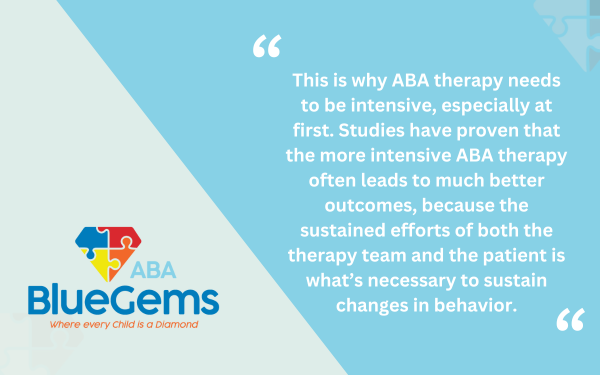Why is ABA Therapy a Long-Term Commitment?
Applied behavior analysis (ABA therapy) has long been considered the gold standard of treatment options for children with autism spectrum disorder (ASD). The statistics back up this claim, too, with studies revealing that the success rate for children who undergo ABA therapy is close to 90%.
As a science- and evidence-based approach to learning and behavior, ABA therapy can help children make significant gains in communication and social interaction skills, as well as modifying negative behaviors.
All ABA therapy plans are customized to each individual child, so that treatment plans can cater specifically to their unique strengths, challenges and preferences. This allows specific goals to be set, and progress toward those goals measured, so that adjustments can be made as necessary.
To be successful, ABA therapy often requires a long-term commitment. In this article, we’ll discuss why this is true.
Table Of Contents
What Commitment is Necessary for ABA Therapy Success?
Autism can range a wide spectrum, both in terms of the severity of the symptoms as well as the levels of support that each child might need. This is a big positive of ABA therapy, since the treatment program can be catered differently to meet every unique individual in unique and specific ways.
That aspect of ABA therapy also makes it a little difficult to give a generic answer to what type of commitment is necessary to realize success with the treatment. At the same time, most children who get ABA therapy require 25 hours of treatment each week.
Children with more severe forms of autism may need even more than that.
It’s also typically true that children require more hours of ABA therapy per week in the initial stages of their treatment — which might cover the first year or so of the therapy. As they go through this intensive therapy and begin to make progress, it’s possible that they might not require as many hours per week.
Still, ABA therapy results in the most successful and sustainable outcomes when it’s administered consistently over time.
Why Does ABA Therapy Require a Long-Term Commitment?
ASD is a neurodevelopmental disorder that affects people for their entire lives. There is no cure for autism, only treatment methods that can help address the symptoms.
Because of this, ABA therapy techniques and strategies need to help support people with autism throughout their lives. It’s always important for individuals with autism to rely on what they’ve learned in treatment to help support them at whatever stage they are in their lives, though they may not require this assistance from other people as they get older and build skills that help them live independently.
In the earlier stages of ABA therapy, though, children are learning completely new concepts. They are being taught skills that the struggle with — sometimes significantly — and are trying to overcome some of the roadblocks that stand in their way.
This is why ABA therapy needs to be intensive, especially at first. Studies have proven that the more intensive ABA therapy often leads to much better outcomes, because the sustained efforts of both the therapy team and the patient is what’s necessary to sustain changes in behavior.

What Are Some of the Factors That Influence the Success of ABA Therapy?
In addition to making a long-term commitment, there are other important factors that play a role in the success of ABA therapy.
One is how severe the child’s symptoms are. In this regard, the definition of “success” might be a lot different for a child with severe symptoms versus that of a child with mild symptoms. For example, success for the former could include learning how to speak, while success for the latter could be defined by progressing through a traditional classroom education environment.
Another factor that plays a big role in positive outcomes is parental involvement. Parents are able to work directly with therapists to learn ABA therapy strategies and tools so they can reinforce the skills that are learned in sessions for real-world scenarios.
This helps to ensure that strategies are consistently applied at all times, and makes it easier for skills to be generalized to other environments.
Finally, the quality of the ABA therapy program itself factors significantly into positive results. The more structured and consistent the program is, the better the outcomes likely will be.
Blue Gems ABA Ensures Consistent, Long-Term Growth for Children with ASD
ABA therapy is certainly a long-term commitment, but it can produce amazing results for children with ASD. This consistent approach helps children build the communication and social skills they often struggle with, while helping them modify negative behaviors.
At Blue Gems ABA, our team of experienced therapists create consistent and well-structured ABA therapy treatment plans that cater to each individual patient we see. In this way, we help children with autism live happy, healthy and fulfilling lives, as independently as possible.
To learn more, please contact us today.




